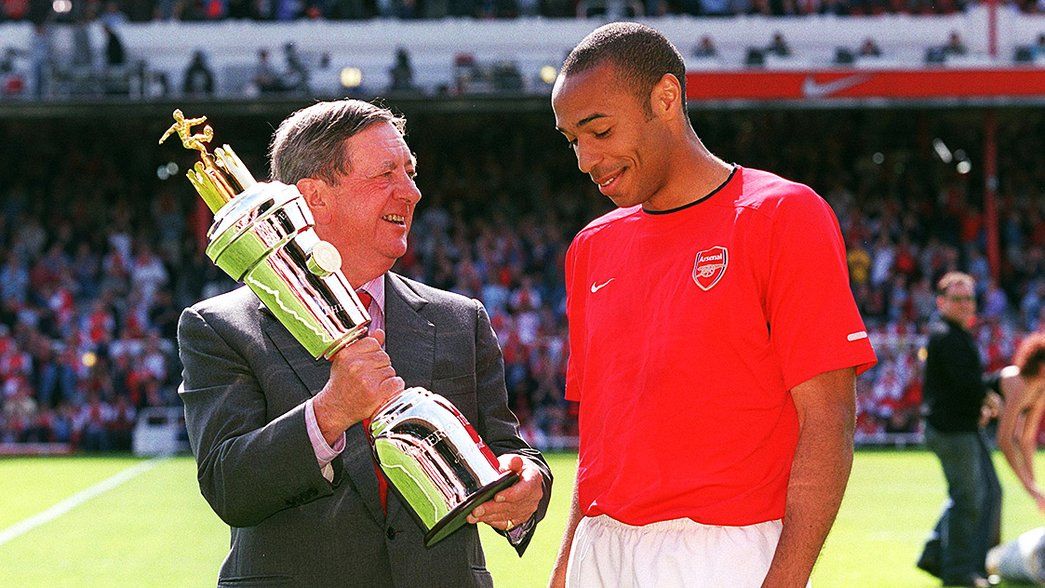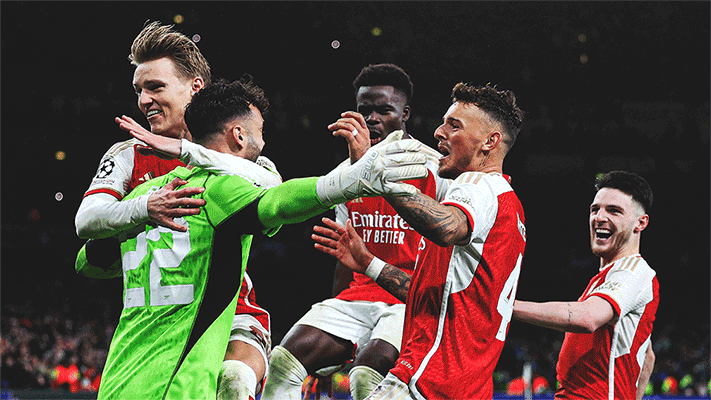This article first appeared in the Arsenal magazine in 2005, written by Andy Exley.
When Arsenal host their first fixture at Emirates Stadium in the summer of 2006, it will be exactly 80 years since Sir Samuel Hill-Wood first became chairman of the Gunners.
The Hill-Wood family had moved down from Derbyshire (where they had run former First Division club Glossop North End) in 1919 and immediately became involved in the Gunners (‘because they were the best football team in the south’, according to Peter Hill-Wood).
Samuel Hill-Wood’s tenure as chairman was followed – after a spell with Sir Robert Bracewell Smith at the helm – by his son Denis in 1962 and after two decades service, the baton was passed to his son Peter, who is now in his 23rd season at the helm. We spoke to the current chairman recently to reminisce about the decades he’s been attending Highbury and look forward to the short move to our new home, Emirates Stadium.

“My first season was back in 1948,” says the chairman, who celebrated his 69th birthday recently. “It was shortly after the war when I came with my grandfather who was the chairman at the time, in those days we would have lunch in the West End then make our way to the ground. Things were different then, the Board of Directors didn’t entertain as happens now. The family would eat in the West End and set off at 2.15 and get to Highbury 2.45. Although in the winter games started earlier as we didn’t have floodlights.
“There weren’t so many motor cars back then of course. Our taxi would park in Conewood Street and we’d all go to the game, including the cab driver who had a season ticket. There was no car parking space within the ground at the time, but we didn’t need it as there were so few cars around, people came on the bus or on the tube.”
Following the war, the Gunners didn’t take long to get into their trophy-winning stride: “We were a very good team at that time,” confirms the chairman, “we won the league in 1948 and the Cup two years later. In those early days, we averaged over 50,000 and the capacity when I started going would have been just under 70,000, though in the ‘30s we had over 73,000 here at Highbury for a match against Sunderland.
“Football was always talked about at home and I always knew I’d be coming to Highbury one day but when you are young you can’t help but be in awe of the place, it just seems so big.” One of the beauties of Highbury, and certainly one of the reasons it is cherished by Arsenal supporters and the footballing fraternity as a whole, is the strong sense of history that pervades the stadium, particularly the famous East Stand with its legendary marble halls entrance. And for the chairman, in one way quite literally, nothing has changed.
“Well I sat in exactly the same seat for the first time I went to Highbury as I do now – we haven’t moved!” He laughs, before explaining that there have been some changes in the old East Stand. “The boardroom has been extended,” he says, “we did that in the summer of 1990, but we retained all the wood panelling. We moved the managing director’s office across which has basically swapped with the men’s bathroom. And of course the next room down from the boardroom on this side was the gym for many years before it became the laundry and now it has become the press office. Obviously both the gym and laundry facilities are now at the training centre.
“As for the rest of the stadium, when I first came, the North Bank was just uncovered terracing, as was the South Stand, but the atmosphere was pretty good. The support was different though of course, everyone came in cloth caps and paid 1d 6s to get in. They were very keen football fans but not quite as demonstrative as you see today.
“We had a very good run towards the end of the 1950s,” continues the chairman, “and through into the 1960s. We had an evening match against Leeds in the mid-60s at the end of the season, when we had nothing to play for and there were just over 4,000 people in Highbury, which was pretty soulless as you can imagine.
“It really makes you realise that although our supporters are very loyal, you don’t want to see your team getting beaten more often than not. It also reminds you of what a miraculous job Arsène Wenger has done – long may it continue.”

The chairman mentions less successful times in the 1960s, but the worry for many clubs in subsequent decades came not from performances on the pitch, but unruly behaviour off it as football hooliganism reared its ugly head, with many London grounds resembling battle fields in the ‘70s and ‘80s.
Thankfully, Highbury has always been a relatively safe place to watch football, as the chairman explains: “I think the crowds here have always been pretty good in that respect and I believe that can be put down to two things. Firstly I genuinely think Arsenal fans are a pretty good bunch of people and secondly the stewarding at Highbury has always been excellent.
“We used to have what were called ‘honorary stewards’ – we had them here for as long as I can remember and after they were phased out a younger group have carried on the good work. There were always stewards around the pitch and I think we were pioneers in that respect. The honorary stewards weren’t paid but we gave them a lavish dinner once a year at the Park Lane Hotel, which they enjoyed.”
Following the Hillsborough disaster, it was all-change for every professional football club, as terracing was outlawed in the Taylor Report, changing the complexion of Highbury forever. “We were obviously given no option following the Taylor Report, the terracing had to go,” says Mr Hill-Wood. “People thought the atmosphere would go and there were many people who believed all-seater stadiums weren’t necessarily the answer, but it’s done now.
“I’m not convinced there was a need to completely do away with terracing. Seating in old grounds brings its own problems, you only have to look at areas of Highbury now. In the lower tier, if we get a corner, when one person stands up then the person behind them has to do the same and a ripple effect means a lot of people are standing up a lot of the time and it’s the same at many grounds. Before, when everyone stood up there wasn’t this problem and we never really had any problems on the terracing here.”
Nevertheless, both the North Bank and the Clock End (South Stand) had to be redeveloped. Hospitality boxes were added at the South Stand and, famously, a mural of supporters stood in place while the new North Bank was being built.

“Luckily with the redevelopment of the North and the South Stand we didn’t have to go into debt because the Hospitality Boxes financed the building,” says the chairman. “I don’t think anyone had seen a mural before. But there have been a lot of firsts at Highbury, undersoil heating, floodlights, televised games etc. “The decisions we made in respect of the North and South stands were big ones, but you have to remember that it was a brave decision to build the current East and West Stands in the 1930s. After building those stands we ran into the war of course. We didn’t have any matches and therefore no money so the club was deeply in debt throughout the Second World War.
“It’s nice that we aren’t knocking down those two stands down when we leave. The East and West Stands were definitely ahead of their time and they will really add to the development. Nothing much has changed other than the make-up of the offices. The dressing rooms for example are exactly the same as when they were built in the ‘30s.”
The chairman alludes to our impending departure from Highbury and after an association with the club that has spanned all but six years of Highbury’s existence, you would expect this representative of the Hill-Wood family to be viewing our relocation with a heavy heart. Not a bit of it.
“If we were being nostalgic, we’d stay here, but if you are being realistic you know that we have to go,” he says pragmatically. “Gates of 38,000 aren’t enough to sustain us.
“So to retain the best players and compete with the likes of Chelsea and Man United we have to have more income. Therefore, in the real world, we need a stadium that holds 60,000 people, you have to forget the nostalgia and sentimentality.
“As a board we deliberated long and hard about what we should do,” reveals the chairman. “At one point we decided we would stay and then we realised that we couldn’t really add to the seats here. And also a lot of the facilities at Highbury aren’t adequate for the modern day, hospitality for example, we’re very much hand to mouth here.”

From his central position in the directors’ box, Mr Hill-Wood can see the tower cranes from the new site looming large over the West Stand, a reminder of the advanced stage of the Emirates Stadium development. And despite initial scepticism, the chairman can’t wait to start a new chapter in the Arsenal story.
“I really didn’t think we’d raise the money to be perfectly honest,” he muses, “but we have, it’s all in place and now we can just look forward.
“I’ve forgotten my allegiances to Highbury and I’m only looking forward to moving to Emirates Stadium which will be magnificent, absolutely awe-inspiring.
“I think there will be some reminders of Highbury,” says Mr Hill-Wood, who will certainly be joined at the new stadium by the bust of his father which currently sits on the Directors’ Landing, “but it will look very different, there will be a lot of glass for example but I’m sure it will be very smart.
“When we run out for the first game there of course I’ll be thinking of my father and grandfather and I’m sure they would be proud of what we’ve done, moving into the 21st century having made a brave decision.”
And before we play the first game at the new stadium there will of course have been a final fixture at Highbury and many a lump in Gunners fans’ throats.
“I still get a buzz when I walk through the front door at Highbury, there is just such a tremendous atmosphere to the place,” says Mr Hill-Wood. “The final match will be a very emotional day, for everyone. Each fan has their own emotional memories. I was almost born here and have been coming nearly 60 years and I’ll miss the place, but I’m not going to cry about it.”

Copyright 2024 The Arsenal Football Club Limited. Permission to use quotations from this article is granted subject to appropriate credit being given to www.arsenal.com as the source.










